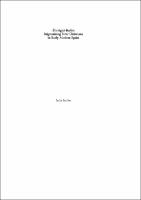| dc.contributor.author | Gebke, Julia | |
| dc.date.accessioned | 2020-06-11T02:00:34Z | |
| dc.date.available | 2020-06-11T02:00:34Z | |
| dc.date.issued | 2020 | |
| dc.identifier.uri | http://library.oapen.org/handle/20.500.12657/39507 | |
| dc.description.abstract | The ideology of purity-of-blood (limpieza de sangre) divided
early modern Iberian society into two different classes: Old
Christians and New Christians. New Christians, i.e. Conversos (converted Jews) and Moriscos (converted
Muslims), but also their offspring, were thought to be inferior Christians and always tending towards apostasy. At the turn of the 17th century an increased interest in bodily markers to proof the presumed inferiority of the so-called New
Christians can be observed. The book focusses on the question how the apologists of the purity-of-blood statutes
used the idea of inherited bodily markers to promote a
genealogical racism in early modern Iberia.
German Version: https://e-book.fwf.ac.at/o:1377 | |
| dc.language | English | |
| dc.subject.classification | thema EDItEUR::N History and Archaeology::NH History::NHT History: specific events and topics::NHTB Social and cultural history | en_US |
| dc.subject.classification | thema EDItEUR::N History and Archaeology::NH History::NHD European history | en_US |
| dc.subject.classification | thema EDItEUR::N History and Archaeology | en_US |
| dc.subject.classification | thema EDItEUR::3 Time period qualifiers::3M c 1500 onwards to present day | en_US |
| dc.subject.classification | thema EDItEUR::M Medicine and Nursing::MB Medicine: general issues::MBX History of medicine | en_US |
| dc.subject.classification | thema EDItEUR::Q Philosophy and Religion::QR Religion and beliefs::QRA Religion: general::QRAX History of religion | en_US |
| dc.subject.classification | thema EDItEUR::J Society and Social Sciences::JB Society and culture: general::JBS Social groups, communities and identities::JBSF Gender studies, gender groups | en_US |
| dc.subject.classification | thema EDItEUR::J Society and Social Sciences::JB Society and culture: general::JBS Social groups, communities and identities::JBSL Ethnic studies::JBSL1 Ethnic groups and multicultural studies | en_US |
| dc.subject.classification | thema EDItEUR::J Society and Social Sciences::JB Society and culture: general::JBS Social groups, communities and identities::JBSL Ethnic studies | en_US |
| dc.subject.other | Conversos, Moriscos, New Christians, Purity of Blood, Spain, Early Modern Period, Racism | en |
| dc.subject.other | ÖFOS 2012, History of science | en |
| dc.subject.other | ÖFOS 2012, Modern history | en |
| dc.subject.other | ÖFOS 2012, European history | en |
| dc.subject.other | Conversos, Morisken, Neuchristen, Blutreinheit Ilimpieza de sangre, Spanien, Frühe Neuzeit, Rassismus | de |
| dc.subject.other | ÖFOS 2012, Wissenschaftsgeschichte | de |
| dc.subject.other | ÖFOS 2012, Neuere Geschichte | de |
| dc.subject.other | ÖFOS 2012, Europäische Geschichte | de |
| dc.title | (Foreign) Bodies: Stigmatizing New Christians in Early Modern Spain | en |
| dc.type | book | |
| dc.type | book | |
| oapen.abstract.otherlanguage | Um Mechanismen der Ausgrenzung, Diskriminierung und Verfolgung zu durchschauen, ihnen vorzubeugen und sie
beizeiten zu bekämpfen, müssen wir sie verstehen. Die
Blutreinheitsideologie (span. limpieza de sangre) unterteilte
die frühneuzeitliche iberische Gesellschaft in zwei Gruppen:
Altchristen und Neuchristen. Julia Gebke analysiert in ihrer
Arbeit anhand von drei durch die Blutreinheitsideologen
propagierten körperlichen Markierungen im Schnittfeld von Theologie und Medizin die verstärkte Stigmatisierung des
neuchristlichen Körpers. Neuchristliche Muttermilch, jüdisch-männliche Menstruation und neuchristlicher Körpergeruch
wurden, speziell an der Schwelle vom 16. zum 17.
Jahrhundert, von Befürwortern und Gegnern der
Blutreinheitsideologie kontrovers diskutiert.
Deutsche Version: https://e-book.fwf.ac.at/o:1377 | |
| oapen.identifier.doi | 10.7767/9783205209874 | |
| oapen.relation.isPublishedBy | af16fd4b-42a1-46ed-82e8-c5e880252232 | * |
| oapen.relation.isFundedBy | 0bdd30b8-28cc-4e2d-bd69-6cabb77b36d4 | |
| oapen.collection | Austrian Science Fund (FWF) | |
| oapen.imprint | Böhlau | |
| oapen.grant.number | PUB 535 | |

